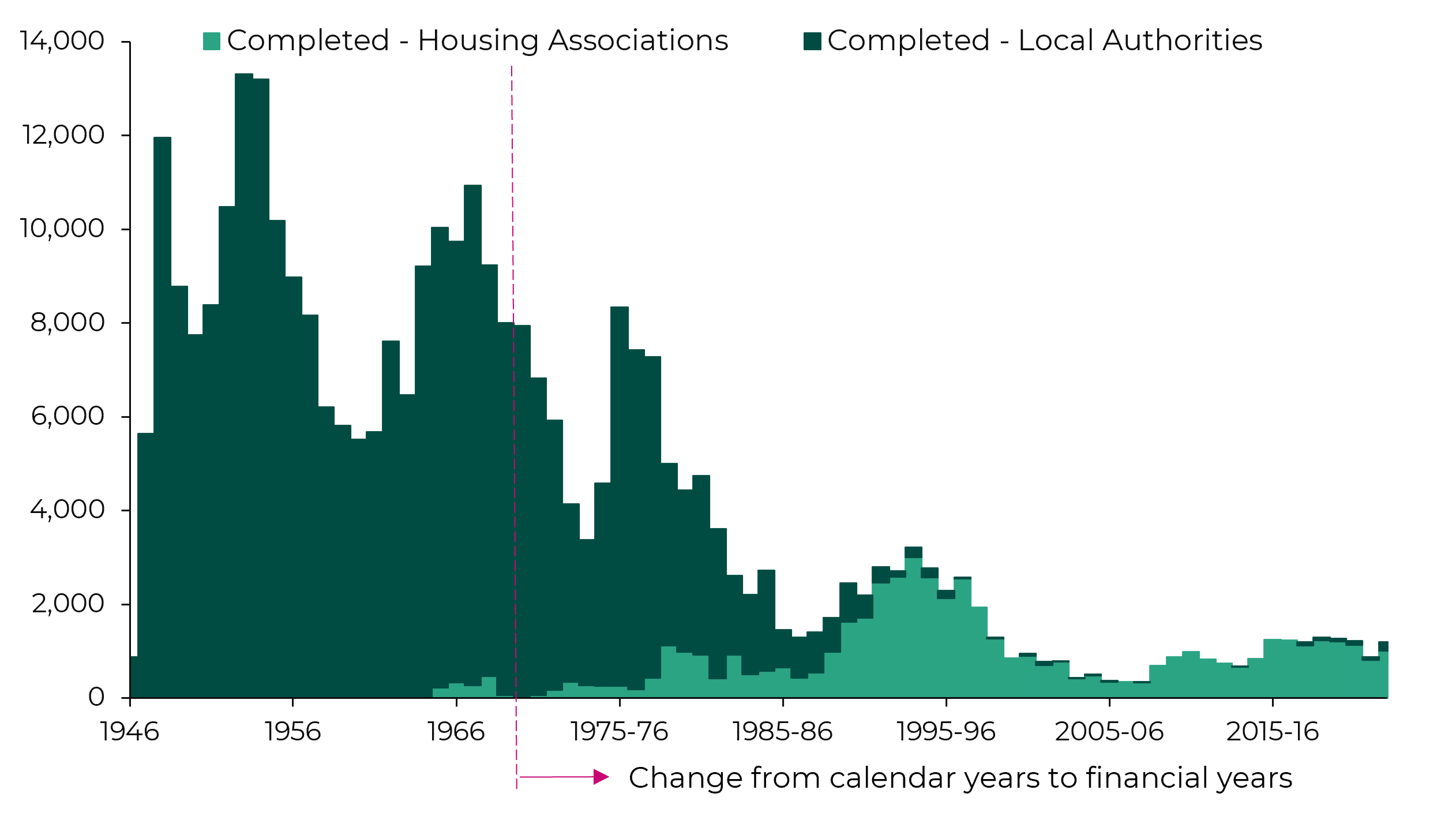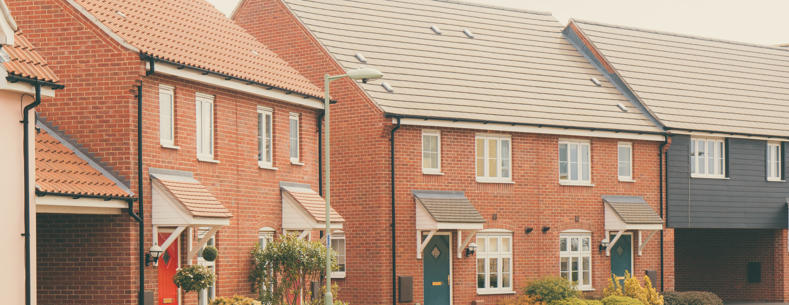Increasing the number of social homes is a cornerstone of the Welsh Government’s plans to prevent housing problems and homelessness.
The Welsh Government set a target of delivering 20,000 new low carbon homes for social rent during this five-year Senedd term, 2021 to 2026. In the first two years, 5,775 homes were delivered towards the target.
This figure doesn’t just include newly built homes. It also includes existing homes that social landlords buy, and homes that they produce by renovation or remodelling. Some are provided by private developers under agreements with local authorities.
Building new social housing has ‘never been more difficult’, according to the representative body for housing associations Community Housing Cymru (CHC).
Now, an inquiry by the Senedd’s Local Government and Housing Committee will consider whether the Welsh Government can improve its strategic approach.
Return to the postwar housebuilding boom?
It hasn’t always been this hard to build social housing. In fact, over a thirty-year period between the mid-1940s and the mid-1970s, an average of around 8,000 new social homes were built every year in Wales.
By contrast, there were 1,203 new build dwellings completed by social landlords in 2022-23.
Figure 1: New build dwellings completed by social landlords in Wales, 1946 to 2022-23*

Source: Office for National Statistics, accessed 7 February 2024.
* Data to 1969 are based on calendar year. Data after 1969 are based on financial year.
Much has changed in the housing market since those postwar decades, and many of those homes weren’t built to today’s standards. Even so, a number of UK academics, charities and think tanks argue that governments should revive some of the methods that underpinned that house building boom.
A common theme in their work is a stronger role for the public sector in strategically planning, designing and leading the delivery of large-scale development. Several reports advocate the creation of a publicly accountable corporation to lead on assembling public and private land into large sites, raising finance, developing master plans, handling the planning consents, and inviting bids for plots from developers.
In the postwar period the New Town Development Corporations took on this role. Land development corporations in Denmark, Canada and South Korea are among current international examples.
The Joseph Rowntree Foundation argues that ‘rekindling this form of large-scale development – to create great new places to live and work, with a strong bias towards pro-security tenures for those poorly served by the current market – can make a significant contribution to meeting housing need in areas of high demand.’
What’s the current approach?
The main way in which the Welsh Government supports social housing development is by making Social Housing Grant available to landlords.
The Scottish Government, which has similar aims to build social housing at scale, is proposing to cut funding for affordable housing by 26% in 2024-25. In contrast, the Welsh Government’s draft budget for that year is cutting Social Housing Grant by 1.5%, to £325 million.
Another grant that funds social housing provision is the Transitional Accommodation Capital Programme (TACP). This was introduced in 2022-23 to support projects that deliver housing quickly in a flexible way, including through buying existing homes, remodelling, and modern methods of construction.
In its first year TACP supported social landlords with £76.4 million to deliver 936 homes. It doesn’t have its own line in the budget but is funded through underspends and top-slicing Social Housing Grant.
Providing grant puts the onus on social landlords to come forward with proposals for new sites, but several factors are making this challenging for landlords to do.
In written evidence on the draft budget, Community Housing Cymru cited barriers including planning delays and complexity, rising costs due to inflation, and ongoing uncertainty about how the sector can afford to decarbonise existing homes.
What else is happening?
As well as providing grant funding, the Welsh Government is exploring other approaches. The Cooperation Agreement includes a commitment to establish Unnos, a national construction company.
Plaid Cymru’s proposal for Unnos describes a publicly-owned company, answerable to the Senedd, that would raise long-term finance and assemble public and private land, promoting good construction practice and Welsh supply chains.
The Welsh Government provided Unnos with £1 million revenue funding in 2023-24 and has promised a further £1 million in 2024-25 to fund its initial development.
Unnos wasn’t mentioned in the Cooperation Agreement’s annual report for 2022-23 but the First Minister gave a verbal update during scrutiny on 8 December 2023. He said that core objectives had been agreed, including improving supply chains, promoting modern methods of construction, bringing empty homes back into use, and overcoming barriers such as phosphates.
As well as providing grant and developing objectives for Unnos, the Welsh Government is getting more directly involved in housing provision through a series of so-called ‘exemplar sites’.
Using land currently owned by the Welsh Government, as well as buying more land, the Welsh Government’s Land Division is working with developers and investors to support the construction of around 6,000 homes across 27 sites over the next five years, of which around 2,600 will be affordable.
In draft budget scrutiny on 18 January 2024 the Minister for Climate Change, Julie James MS, told the Committee:
We’re very keen to make sure that we use Welsh Government land to show people what can be done – what can be developed in a way that gives you a decent return on your money, but also really excellent mixed-use developments, mixed-tenure developments, as well.
Some sites are being taken forward through partnership with Tirion Homes, a not-for-profit residential developer that the Welsh Government and Principality Building Society helped to found in 2012. Tirion has led developments at The Mill in Canton, Cardiff and Royal Victoria Court in Newport without using Social Housing Grant.
Another tool in the Welsh Government’s toolbox is the Levelling Up and Regeneration Act 2023. This legislation empowers Welsh Ministers to direct that particular affordable housing developments are in the public interest. This would have the effect of varying the rules governing compulsory purchase, meaning that land for those developments could be bought more cheaply.
The Welsh Government made a statement about these new powers in August 2023 but has not said anything since.
Will it be enough?
In November the Minister said she was ‘holding on’ to the 20,000 target and added that ‘we didn’t think that we’d do 4,000 a year for five years’:
If you look at the last Senedd term, actually, the target accelerated because we put the money in this end, and it takes a while for it to come through and out the other end.
If the target is met, the Committee is keen to consider whether it will be enough to meet housing need.
The inquiry will hear from a range of experts and will be asking whether the Welsh Government is making full use of all its tools; whether there are lessons to learn from elsewhere; and whether it’s possible to think bigger and scale up to deliver more.
A call for written evidence is live until 19 April 2024.
Article by Jennie Bibbings, Senedd Research, Welsh Parliament






